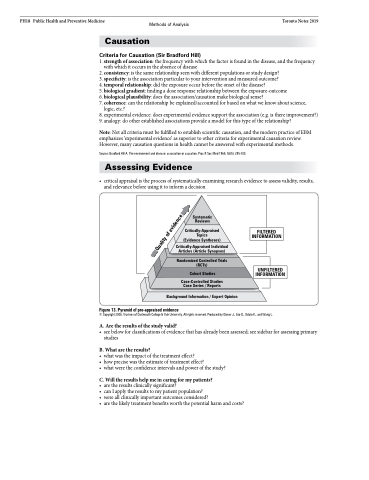Page 1236 - TNFlipTest
P. 1236
PH18 Public Health and Preventive Medicine Methods of Analysis Toronto Notes 2019 Causation
Criteria for Causation (Sir Bradford Hill)
1. strength of association: the frequency with which the factor is found in the disease, and the frequency with which it occurs in the absence of disease
2. consistency: is the same relationship seen with different populations or study design?
3. specificity: is the association particular to your intervention and measured outcome?
4. temporal relationship: did the exposure occur before the onset of the disease?
5. biological gradient: finding a dose response relationship between the exposure-outcome
6. biological plausibility: does the association/causation make biological sense?
7. coherence: can the relationship be explained/accounted for based on what we know about science, logic, etc.?
8. experimental evidence: does experimental evidence support the association (e.g. is there improvement?) 9. analogy: do other established associations provide a model for this type of the relationship?
Note: Not all criteria must be fulfilled to establish scientific causation, and the modern practice of EBM emphasizes ‘experimental evidence’ as superior to other criteria for experimental causation review. However, many causation questions in health cannot be answered with experimental methods.
Source: Bradford Hill A. The environment and disease: association or causation. Proc R Soc Med 1965; 58(5): 295-300.
Assessing Evidence
• criticalappraisalistheprocessofsystematicallyexaminingresearchevidencetoassessvalidity,results, and relevance before using it to inform a decision
Systematic Reviews
Critically-Appraised Topics (Evidence Syntheses)
Critically-Appraised Individual Articles (Article Synopses)
Randomized Controlled Trials (RCTs)
Cohort Studies
Case-Controlled Studies Case Series / Reports
Background Information / Expert Opinion Figure 13. Pyramid of pre-appraised evidence
© Copyright 2006. Trustees of Dartmouth College & Yale University. All rights reserved. Produced by Glover J., Izzo D., Odato K., and Wang L.
A. Are the results of the study valid?
• seebelowforclassificationsofevidencethathasalreadybeenassessed;seesidebarforassessingprimary studies
B. What are the results?
• whatwastheimpactofthetreatmenteffect?
• howprecisewastheestimateoftreatmenteffect?
• whatweretheconfidenceintervalsandpowerofthestudy?
C. Will the results help me in caring for my patients?
• aretheresultsclinicallysignificant?
• canIapplytheresultstomypatientpopulation?
• wereallclinicallyimportantoutcomesconsidered?
• arethelikelytreatmentbenefitsworththepotentialharmandcosts?
FILTERED INFORMATION
UNFILTERED INFORMATION
Quality of evidence


